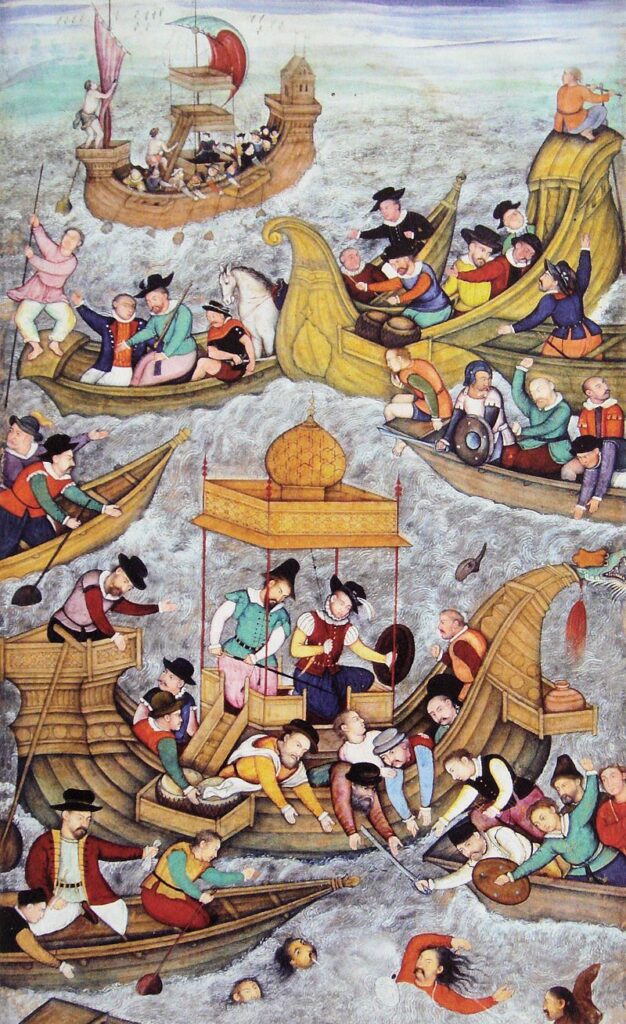Akbar the Great is further known as Abu’l-Fath Jalal-ud-din Muhammad Akbar:
Greatest of the Mughal emperors in India at the period of 1556–1605. Akbar was born on Oct. 15, 1542, in Umerkot which is located today in Sindh province, Pakistan. He departed his life on 27 October 1605 in Agra, India. As a young man, Akbar, whose forebears included Timur and Genghis Khan, succeeded to the throne. Initially, his power was limited to Punjab and the Delhi region.
In 1562, the Rajput ruler of Amber (Jaipur) recognized his suzerainty, and other Rajput rajas did the same. Rajput lords and other Hindus were incorporated in the highest ranks of Akbar’s government, and discrimination against non-Muslims had reduced.


Humayun, the Mughal dynasty’s second emperor, fled after being defeated by Sher Shah Suri at the battle of Kanauj in May 1540. Rana Prasad, the Hindu king, provided him and his pregnant wife Hamida Banu Begum asylum. Lawful to Humayun’s exile and endless movement, Akbar was brought up by his paternal uncle, Kamran, Askari Mirza.
As he grew older, he learned to hunt and fight with a variety of weapons, preparing himself to become India’s greatest warrior and ruler. Even though he never learned to read or write as a child, his thirst for knowledge was unquenchable.
With the military assistance of Persian king Shah Tahmasp I, Humayun regained Delhi in 1555. Soon after reclaiming his throne after an accident, Humayun met his tragic fate. At the time, Akbar was 13 years old, and the young Emperor’s Regent was Humayun’s trusted general Bairam Khan.
In November 1551, Akbar married his paternal uncle Hindal Mirza’s daughter Ruqaiya Sultan Begum. After assuming the kingdom, Ruqaiya was named his principal consort. On February 14, 1556, in Kalanaur (Punjab), Akbar succeeded Humayun and was given the title of ‘Shahanshah.’ Until the child Emperor reached adulthood, Bairam Khan governed on his behalf.
Check out our finance-related articles, here we help people understand the basics of financial planning, share tips on saving money, and give you ideas on breaking down bad money habits to help you on the path to financial success.
The Second Battle of Panipat


In 1556, Hemu, the Hindu ruler, won the Mughal emperor Akbar’s armed troops in the Second Battle of Panipat.
Hemu had taken control of Delhi and Agra. He crowned himself Raja Vikramaditya after overthrowing the Mughal emperor Tardi Beg Khan in a coronation held in Purana Quila.
Bairam Khan was designated as Akbar’s guardian since he was too young to take over the throne. When Bairam Khan learned of the loss of Delhi and Agra, he set out to reclaim them.
The Second Battle of Panipat was fought in Panipat when the two armies converged. Despite having a greater army than Hemu, the Mughals were victorious.
Taking Down the Opposition
The Second Battle of Panipat signaled the start of the Mughal Empire’s glory days in India. Akbar was determined to put an end to any Afghan claims to the throne in Delhi. Bairam Khan kidnapped and imprisoned Hemu’s relatives.
Sikander Shah Sur, Sher Shah’s successor, was forced out of North India and obliged to surrender in Bihar in 1557. Muhammed Adil, another Afghan contender for the throne, was killed in a battle the same year. Others were forced to depart Delhi and the surrounding areas, seeking asylum in neighboring states.
Check out our Science related articles, Here we cover science news such as current scientific topics, scientific environment, space, the cosmos, Interesting Technological science, and so on.
The Religious Policy of Akbar
During Akbar’s reign, he was known for his religious tolerance and liberal views. Although Akbar was deeply religious, he never attempted to put his religious principles on anyone, whether it was prisoners of war, Hindu spouses, or the common people of his realm.
He placed a high value on freedom of choice and repealed religiously discriminating levies. In his reign, he supported the construction of temples and even churches. He prohibited the preparation of beef in the kitchens out of respect for the Hindu members of the Royal Family.
Akbar became a devotee of Sheikh Moinuddin Chishti, a prominent Sufi mystic, and developed more pilgrimages to his shrine in Ajmer. He desired religious harmony among his people and formed the Din-i-Ilahi sect with that goal in mind.
Architecture
During his reign, Akbar commissioned the construction of multiple forts and mausoleums, establishing a distinct architectural style that aficionados refer to as Mughal architecture.
The Agra Fort (1565–1574), Fatehpur Sikri (1569–1574) with its majestic Jami Masjid and Buland Darwaza, Humayun’s Tomb (1565-1572), Ajmer Fort (1563-1573), Lahore Fort (1586-1618), and Allahabad Fort (1586-1618) are among the architectural marvels commissioned during his reign (1583-1584).
Art
He valued intellectual debate and granted patronage to several highly skilled individuals whom he brought to his court. The Nava Ratnas, or the Nine Gems, were a group of people who were known as the Nava Ratnas.
Faizi, Mian Tansen, Birbal, Raja Todar Mal, Raja Man Singh, Abdul Rahim Khan-I-Khana, Fakir Aziao-Din, and Mullah Do Piazza were among them. They arrived from divergent backgrounds and were venerated by Akbar for their expertise. Thus, The reign of Akbar had a profound impact on Indian history.
